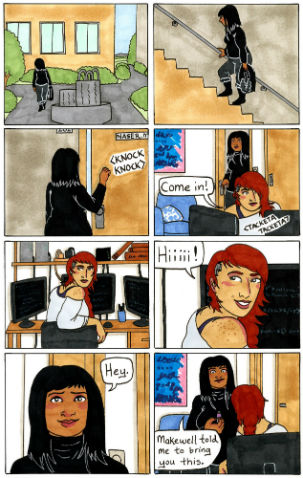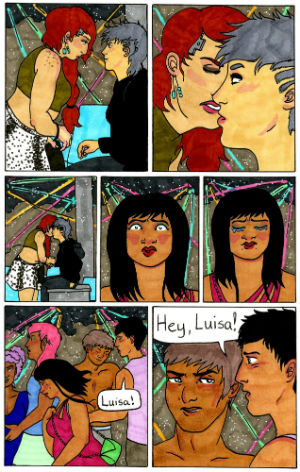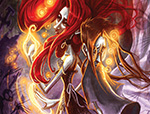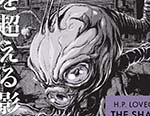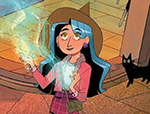
There’s been a recent trend of indie comics artist taking on the tropes of the superhero comic as either a means to critique the genre or to use the genre’s built-in visibility to encode stories not regularly seen within. Virginia Paine’s long running webcomic The WHYs is an excellent and vastly under-discussed version of the latter. Chronicling the induction of pyromancer Luisa Reyes into the ERA school for teenagers gifted with superhuman abilities, The WHYs feels like an X-Men homage, right down to the clever play on words in the title. What separates The WHYs from the material it is referencing is not only the upfront decision on Paine’s part to focus on predominantly queer characters but also her subtle but equally conscious choice to ethnically diversify her cast. What is even more fascinating about Paine’s work here is the way in which her usage of the aesthetics and storytelling techniques of indie comics fundamentally alters the form of the stereotypical super-powered teenagers storyline into something unique.
While currently on hiatus, The WHYs first book and handful of subsequent chapters brings the reader deep enough into the world of Weaponized Human Youths to fully invest in the slow-burning story Paine is trying to tell. We follow Luisa as she is granted entrance to the ERA’s Enfield facility for training, makes friends with a few of her fellow gifted teens, gets romantically involves with others, and eventually is sent into the field to do super-human super-spy work. Out of context, the macro plot is nothing out of the ordinary for the genre, though the larger focus on interpersonal relationships within a school framework feels like it is drawn more from Eastern comics than Western. Another deviation is that within the entirety of the first book’s 178 pages, Paine only spends a handful of pages putting her characters into any form of immediate danger. Even withholding the stock standard clash of super-powers in favor of quick brutality and the a focus on the aftermath of that violence.
This alternate pacing is what makes The WHYs so unique is comparison to the genre it is playing off of. Paine is not just telling a super-teens story with indie comics art, she is telling it with slice-of-life comics techniques. Her camera rarely cuts around in a single scene, though it will lightly zoom or pan to track the subject of the shot. Silent moments are held in a way that would be completely antithetical to a more narratively driven story, but here gives the events a more grounded and naturalistic tone. Paine will show Luisa walking through an environment to not only physically set the scene, but to allow for the reader to contemplate her thoughts and feelings.
 This quieter tenor is further reflected in the dialogue, as Paine’s teenagers never affect the too clever slang or affectations of teenagers in other mediums. It makes them feel a bit older than they technically are, but also more fully human. While Luisa is our somewhat naïve point of view character, none of the other characters fall into easy teenage archetypes. Equally subdued (with a couple clumsy exceptions early on) is the way in which the cast comments on their diverse nature. Little melodrama is wringed from the characters’ varied races, genders, body types, and sexuality; so that just like teenagers having super-powers, this diversity is simply a given in the world of The WHYs. It’s an interesting take on a theme explored in mainstream mutant comics wherein the standard minority group distinctions fade into the background once there are people with super-powers. In having the teenagers at Enfield (and their families) as accepting of each other as they are, it suggest without saying that the reader should be as well.
This quieter tenor is further reflected in the dialogue, as Paine’s teenagers never affect the too clever slang or affectations of teenagers in other mediums. It makes them feel a bit older than they technically are, but also more fully human. While Luisa is our somewhat naïve point of view character, none of the other characters fall into easy teenage archetypes. Equally subdued (with a couple clumsy exceptions early on) is the way in which the cast comments on their diverse nature. Little melodrama is wringed from the characters’ varied races, genders, body types, and sexuality; so that just like teenagers having super-powers, this diversity is simply a given in the world of The WHYs. It’s an interesting take on a theme explored in mainstream mutant comics wherein the standard minority group distinctions fade into the background once there are people with super-powers. In having the teenagers at Enfield (and their families) as accepting of each other as they are, it suggest without saying that the reader should be as well.
Later in the series major plot details are revealed in a similar casual manner. Over the years Pain was working The WHYs you can see her start to trust the readers more and more when it comes to receiving her hints and messages. It not only leads to some excellent bits of dramatic irony as far as the plot is concerned, but it also lets the reader determine what it is that is drawing them to this story; be it the mystery and intrigue of a world in which super-powered teens are part of never-fully-elaborated-on strife between the United States and Canada, or the awkward teenage friendships and romances in Luisa’s life.
An even larger area of growth for Paine over the course of the series is her rendering technique. While she had a good handle on the framing and pacing from the start, early pages may have muddied colors owing to her use of what appears to be colored markers. Later on in the series she will gain mastery over this technique as best exemplified in a scene where the characters go out for a night on the town, and eventually replaces it with an equally effective use of digital color. Her character’s facial performances early on are at times awkward or their bodies overly rigid, but as with all cartoonists the longer she spends drawing them the more animated and fluid they become. Their faces and movements start to take on their own character and feel less like variations on a similar model.
All of this artistic progress starts to dovetail nicely when the story becomes more action-oriented in the fifth chapter. Paine competently handles scenes of Luisa facing down armed guards with her pyro-kinetics and escaping on a helicopter. Though even this sequence is more character-focused as the banter between her and her partner in the field Paul is given the foreground over the data heist they are committing. It is in the seventh chapter that Paine is firing on all cylinders as she seamlessly mixes romance, espionage, and super-powered action together in the wake of a disaster.
 Luisa has to run from her girlfriend’s bed to join Paul in surveying the aftermath of a bombing only to find her ex-girlfriend and, unbeknownst to her, the super-powered woman behind the attack amid the rubble. The stunning panels of Luisa and Paul silently walking through the carnage and of her blasting away a rock with fire show the dramatic leaps Paine has taken has an a cartoonist over the course of the book. Making her decision to rush past a confrontation between Luisa and an opposing group of super-powered teens to climax with a gut-shot Paul revealing that the mole within their group is Luisa’s new girlfriend feel like a statement of purpose. The real tension in The WHYs is less about the outside threats, but more about how those threats effect the characters internally.
Luisa has to run from her girlfriend’s bed to join Paul in surveying the aftermath of a bombing only to find her ex-girlfriend and, unbeknownst to her, the super-powered woman behind the attack amid the rubble. The stunning panels of Luisa and Paul silently walking through the carnage and of her blasting away a rock with fire show the dramatic leaps Paine has taken has an a cartoonist over the course of the book. Making her decision to rush past a confrontation between Luisa and an opposing group of super-powered teens to climax with a gut-shot Paul revealing that the mole within their group is Luisa’s new girlfriend feel like a statement of purpose. The real tension in The WHYs is less about the outside threats, but more about how those threats effect the characters internally.
In many ways The WHYs is the comic everybody says they want. It is a diverse young-adult adventure story with plenty of narrative and emotional hooks. It is perhaps it is Paine’s lack of pyro and ballyhoo in both the plot and the performances that prevents this work from clicking with a larger audience. Yet to remove that subdued element would be to take away what makes the work special. The reader comes to really care about Luisa and her friends because we get to spend so much private time with them. With Paine quickly raising the stakes for her protagonists at the end of the first book and into the second, it should be exciting to see how she handles the characters both in their inner and external conflicts.
Virginia Paine (W/A) • Self Published, Free but support Virginia on Patreon
Review by Robin Enrico








